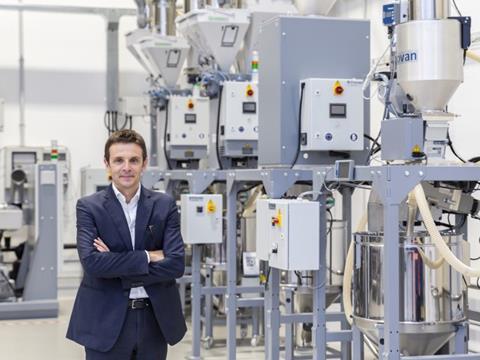
In the most recent of our Sustainability Awards 2021 finalist interviews, Davide Cappellini, CTO at Piovan Group explains the company’s entry Inspecta Be, a finalist in the Machinery category, which helps to simplify the control of Benzene values in PET.
Congratulations on being selected by the international judging panel as a Sustainability Awards 2021 finalist! Would you please introduce your successful entry and what’s innovative about it?
Inspecta is a family of analysers that takes the gas chromatography mass spectrometry (GC-MS) close to the production line of PET, thanks to its compactness, with testing times of 60 minutes maximum.
Inspecta Be (Benzene) was commercialised in 2020 for PET preforms only and in January 2021 extended the testable shapes to granules, sheet and bottles. It allows the complete tracking of production: from raw material acceptance to final product for Consumers and all its measurements can be saved into the database of Winfactory 4.0, the supervision software by Piovan, allowing traceability over time.
In particular, innovation and uniqueness is proven by a patent for the analyser. Differing from the traditional procedures that use a laboratory, Inspecta does not require any preparation such as cryogenic grinding or the involvement of expert technicians. The possibility of installing Inspecta in the production site, its ease of use and rapidity allow results in "almost real time" whereas, preparing the sample, shipping it and analysis at an external laboratory would take several days. Inspecta allows more frequent tests and prompt intervention in cases where Benzene detection is over limits.
Benzene results from rearrangement of terephthalic groups with acids, such as hydrochloric, that, in turn, come from the chlorine component of PVC that may be present from incorrect sorting of post-consumer plastic. PVC is a material typically used for labels and, even if it is mainly responsible for benzene in PET packaging, it is not the only one.
The limitations of packaging depend upon exchange from the surface, temperature and time of residence of the food or beverage in the packaging and it is normally auto imposed to very challenging levels by the producers themselves.
Inspecta Be facilitates the adoption of sustainable packaging materials assuring strict controls on safety aspects for the end users.
Last but not least, Inspecta dramatically reduces the risks of human error in traditional GS-MS in laboratories where the transfer from GS to MS is manual. The process in Inspecta is totally automated, from the sample insertion to results, and can save the report in a database for Quality purposes.
The absence of pre-analysis preparation and manual transfer from GC to MS (both typical of laboratories) assure the consistency of measurements made by different Inspectas worldwide. Something not achievable using local laboratories and particularly helpful for producers with an international footprint to track rPET suppliers and site performances.
What are the environmental challenges in packaging that your entry addresses, and what impact do you hope it will make?

A universally usable packaging material does not exist. The production of glass and metals is enery-intensive and heavy to transport with the related consequences of greenhouse gas emissions and global warming. Paper depletes scarce resources such as land and trees. But each of them, including plastic, has one or more fields of application where it performs better than the other and must not be demonised.
Polymers come as a secondary production from oil refineries. If properly separated and collected, they can be recycled many times avoiding dispersion in the environment and reducing the CO2 emission by its production – 60% of them come from fossil fuel extraction to resin production, according to a white paper from Veolia Plastic.
Inspecta Be simplifies dramatically the control of Benzene values in PET in respect of thresholds and also detects deviations from expected data early and in every step of the production before it gets too late. This assures peace of mind for the producer and simplifies the adoption of sustainable PET packaging, for the end user in particular.
I’d like to ask you about the broader picture beyond your successful entry. ‘Sustainability’ in packaging is multi-dimensional – both in terms of objectives and challenges. Could you comment on the most important roadblocks you identify from your position in the value chain, and the kinds of solutions you would like to see addressing them (e.g. areas of technological innovation, collaboration, regulation)?
Technological innovation in the recycling business industry is moving fast but it cannot compensate for the best practice of End Users in properly sorting the garbage including post-consumer plastic.
The Public Administration must educate and stimulate the Consumers’ behaviors by means of, e.g. deposit scheme. In Norway, this policy drove to recycle 97% of all plastic drinks bottles, 92% suitable for food grade applications. On the other side, where possible, the producers should use mono-material packaging.
Last but not least, the industry of collection and treatment of post-consumer plastic must be more structured to maximised the recycling of all the polymers. PET chain is, by far, the most developed. Probably, HDPE is the polymer with more potential to address these issues quickly.











